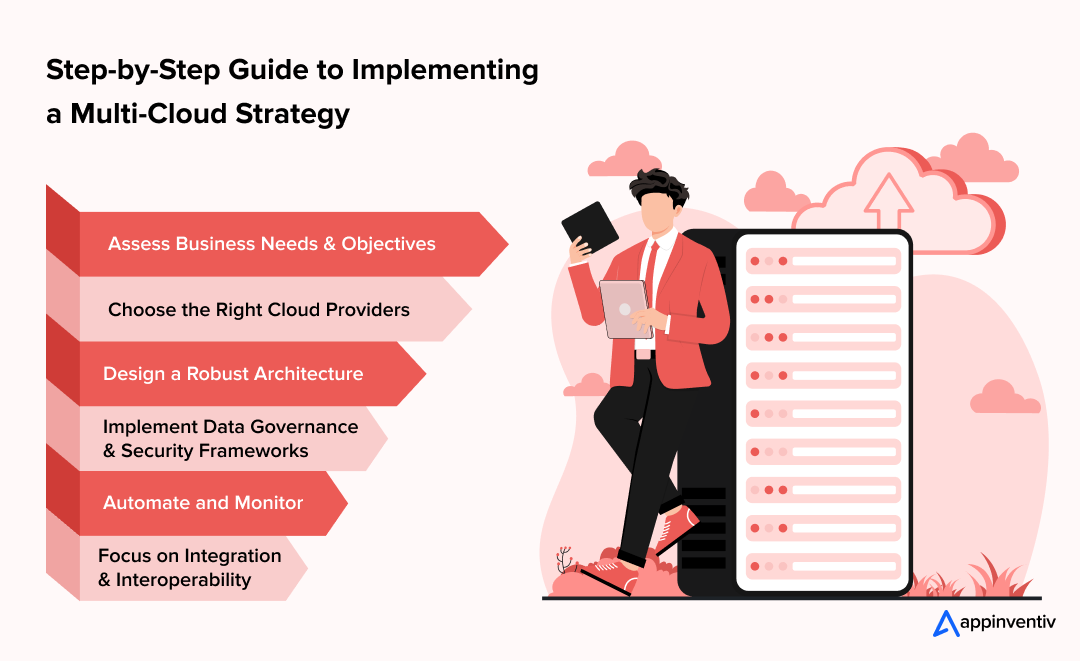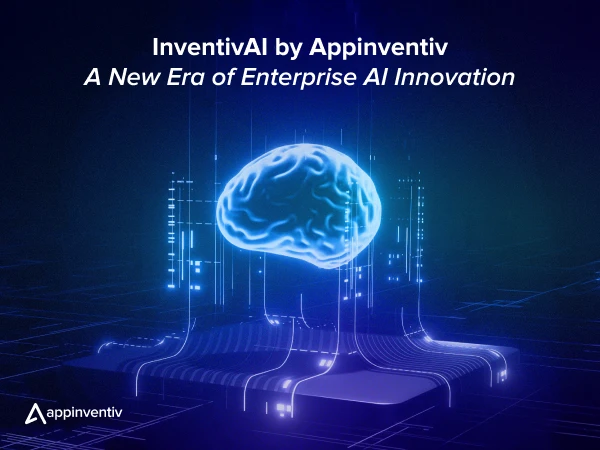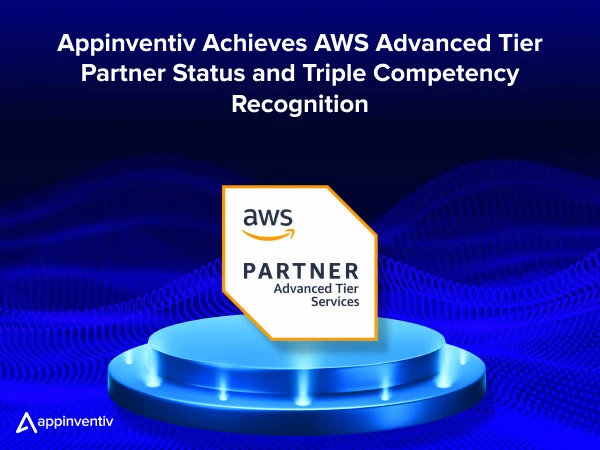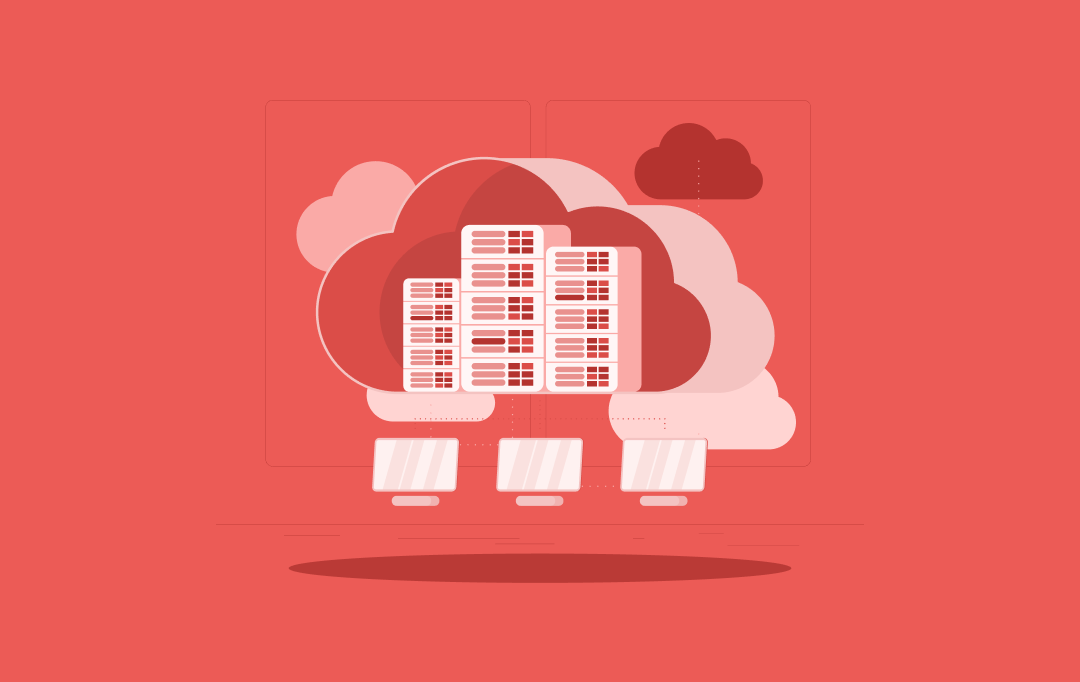- The State of Multi-Cloud Adoption in 2025
- Key Considerations Before Building a Multi-Cloud Strategy
- Understanding Business Needs
- Strategic Cloud Usage Based on Workload Type
- Cloud Security Across Multiple Environments
- Managing Cloud Cost Efficiency through Automation
- Vendor Diversity and Mitigating Risks
- Adapting to Technological Advancements
- How to Implement a Multi-Cloud Strategy?
- 1. Assess Business Needs and Objectives
- 2. Choose the Right Cloud Providers
- 3. Design a Robust Architecture
- 4. Implement Data Governance and Security Frameworks
- 5. Automate and Monitor
- 6. Focus on Integration and Interoperability
- Challenges and Solutions in Multi-Cloud Adoption
- Data Security and Privacy Risks
- Complexity in Managing Cloud Resources
- Vendor Lock-In
- Integration and Interoperability Challenges
- Cost Management and Optimization
- Future Trends in Multi-Cloud Strategy
- 1. Increased Adoption of AI and Machine Learning in Multi-Cloud
- 2. Enhanced Security Features in Multi-Cloud Environments
- 3. The Emergence of Multi-Cloud AI-Powered Automation
- 4. Integration of Edge Computing with Multi-Cloud Architectures
- 5. Expansion of Hybrid and Multi-Cloud Ecosystems
- Why Appinventiv is the Right Cloud Services Provider for Your Multi-Cloud Strategy
- FAQs
Key takeaways:
- Multi-cloud adoption is growing and 76% of enterprises have already embraced multi-cloud environments.
- Avoiding vendor lock-in is a major driver for businesses moving to multi-cloud strategies.
- Cost optimization and enhanced security are key benefits of multi-cloud adoption.
- Businesses must align their multi-cloud strategy with business objectives for scalability, security, and innovation.
- Seamless integration and interoperability across cloud platforms are essential for success.
- Partnering with a cloud services provider can help overcome the challenges of managing multi-cloud environments.
For many businesses today, a single cloud provider can quickly become a critical vulnerability. One unexpected outage, a sudden price hike, or shifting compliance regulations, and your operations could be on the line. In fact, enterprises that relied solely on one cloud provider are already experiencing at least one major disruption. In a world where downtime isn’t just an inconvenience but a potential revenue loss, the risks of being locked into a single provider have never been clearer.
This is where multi-cloud strategies come into play. By diversifying your cloud services across multiple providers, you gain greater control, resilience, and flexibility—ensuring your business doesn’t face the devastating consequences of being overly reliant on a single ecosystem.
However, building a truly robust multi-cloud strategy requires more than just spreading workloads. It demands aligning your infrastructure with business goals, integrating complex data systems, and maintaining tight security across a diverse landscape of platforms.
While multi-cloud solutions offer significant benefits, they also present unique challenges—such as ensuring smooth integration, managing costs, and maintaining compliance. The key to success lies in not only mitigating risks but also unlocking the full potential of cloud technologies to drive business growth and efficiency.
In this blog, we’ll explore how to build a multi-cloud strategy that not only mitigates risk but also drives your business forward—ensuring future-readiness, scalability, and innovation. Whether you’re looking to cut costs, stay agile, or enhance security, this guide will take you through everything you need to consider for a successful, sustainable multi-cloud environment.
Do you know 76% of enterprises have already embraced multi-cloud environments? We can help you navigate the complexities of multi-cloud strategies and unlock the full potential of your business.
The State of Multi-Cloud Adoption in 2025
In 2025, more than 76% of companies had already jumped into multi-cloud setups. As this trend keeps gaining momentum, organizations are spreading their cloud infrastructure across different providers to break free from being stuck with just one vendor, boost their performance, and make their systems more resilient when things go sideways.
PwC has been talking up the flexibility and scalability that come with multi-cloud strategies. When you build a vendor-neutral infrastructure, it gives businesses the power to spin up computing resources quickly, try out cutting-edge technologies, and scale up or down as their needs change. According to their analysis, companies can leverage public clouds for those scalable, experimental projects while keeping their mission-critical systems locked down on private clouds for better security. This approach gives you the flexibility to handle those crazy busy periods without having to maintain expensive servers that sit around collecting dust most of the time.
Gartner also points out something interesting though – while tons of organizations have embraced multi-cloud architecture, actually connecting and managing workloads across multiple providers is still a real headache. Their prediction is pretty sobering: more than 50% of organizations won’t see the results they’re hoping for from their multi-cloud implementations by 2029, mainly because integration is such a pain. When different environments don’t talk to each other smoothly, it ends up slowing down cloud adoption and making multi-cloud management way more complicated than it should be.
The good news is that businesses can work around these roadblocks by teaming up with a dedicated cloud services provider who really knows their way around multi-cloud architectures. These specialists can help smooth out the integration process between different cloud environments, making sure everything actually works together the way it’s supposed to.
The whole multi-cloud movement is only going to get bigger, as organizations want to tap into what each provider does best to improve performance, cut costs, and spark innovation. Here’s a closer look at the key benefits of multi-cloud environment:
| Benefit | Description |
|---|---|
| Improved Flexibility and Agility | Multi-cloud setups let you pick the right service for each task, making it easier to adapt quickly and grow when the market changes. |
| Cost Optimization and Efficiency | Using different cloud providers helps you compare prices and avoid paying for things you don’t need, leading to better cost control. |
| Enhanced Security and Risk Mitigation | Spreading your data and apps across multiple clouds lowers the chances of everything going down at once and lets you choose the best security features each provider offers. |
| Avoiding Vendor Lock-In | You’re not stuck with one provider—multi-cloud gives you the freedom to switch or mix providers without much hassle. |
| Increased Scalability and Innovation | You can grow faster and try new tools or services more easily by using multiple cloud platforms. |
| Improved Disaster Recovery and Business Continuity | Backing up your data across clouds means your business can keep running smoothly even if one provider faces an issue. |
Key Considerations Before Building a Multi-Cloud Strategy
Before implementing a multi-cloud strategy, it’s essential to ensure that it aligns with your business objectives. A well-thought-out strategy can deliver scalability, security, innovation, and cost savings while minimizing risks.

Understanding Business Needs
Your multi-cloud strategy has got to line up with what your business is actually trying to accomplish – things like being able to scale when you need to, keeping your data locked down tight, and staying on top of the latest innovations. Whether you’re planning for rapid growth down the road, making sure sensitive information stays protected, or bringing in some cutting-edge tech, getting crystal clear on these priorities helps you pick the right combination of cloud providers that’ll work for you now and in the future.
Strategic Cloud Usage Based on Workload Type
Pick your cloud providers based on what each workload actually demands – tap into Google Cloud when you need AI capabilities, lean on AWS when you’re looking to scale big, and go with Azure when you’re dealing with hybrid setups. This focused approach means your business gets to use the absolute best cloud tech available for whatever specific task you’re tackling.
Cloud Security Across Multiple Environments
Set up rock-solid security protocols that work the same way across every single cloud platform you’re using – that means encryption, identity management, and access control that stays consistent everywhere. This cuts down your chances of getting hit with a data breach while making sure you stay compliant no matter how many different environments you’re juggling.
Managing Cloud Cost Efficiency through Automation
Bring in automation to handle resource allocation smartly, cut down on those costly human mistakes, and keep your cloud spending from getting out of hand. When you automate your cloud operations, your business can grow efficiently without watching costs spiral out of control.
Vendor Diversity and Mitigating Risks
Make sure your multi-cloud approach keeps you from getting trapped with just one vendor by spreading your business across different cloud providers – this makes you way more resilient when one provider has an outage or decides to jack up their prices. Having that vendor flexibility means you can negotiate better deals and pivot quickly when the market throws you a curveball.
Adapting to Technological Advancements
Build your multi-cloud strategy so it can roll with the punches when new technologies like AI, edge computing, and machine learning come along. This kind of forward-thinking setup ensures your infrastructure can grow and change to support whatever innovations come next.
How to Implement a Multi-Cloud Strategy?
Implementing a successful multi-cloud strategy requires careful planning and execution. By following these key steps to create a multi-cloud strategy, businesses can ensure their multi-cloud architecture is optimized for scalability, security, and cost-efficiency.

1. Assess Business Needs and Objectives
Begin by getting a solid grip on what your business actually needs to accomplish. Whether you’re looking at scaling up, locking down security, or driving innovation, making sure your multi-cloud strategy matches up with these goals is absolutely essential. Figure out which workloads would really benefit from a multi-cloud setup and sketch out exactly what you’re hoping to achieve.
2. Choose the Right Cloud Providers
Pick your cloud providers based on what your business specifically demands from them. A successful multi-cloud architecture in cloud computing leverages the strengths of various providers. For instance, tap into AWS when you need serious scalability, go with Azure for hybrid solutions, and turn to Google Cloud when you’re diving into machine learning capabilities. Each provider should fit like a glove with what your business needs, making sure you build a multi-cloud strategy that actually supports innovation and growth.
[Also Read: AWS Vs Azure Vs Google Cloud – Which cloud platform should you choose for your enterprise?]
3. Design a Robust Architecture
Put together a multi-cloud architecture in cloud computing that can scale and adapt as your needs change. This means getting the right frameworks in place for data integration, making sure different providers can talk to each other smoothly, and figuring out how you’ll spread workloads around. A well-thought-out multi-cloud strategy makes sure you’re getting the most out of your resources and gives you a solid foundation to grow from.
4. Implement Data Governance and Security Frameworks
As you bring different cloud environments together, you’ve got to make sure your security and compliance frameworks are locked and loaded. This includes getting encryption protocols set up, managing identities properly, and running regular audits to keep your data safe across all platforms. Building a secure multi-cloud environment is absolutely critical for protecting sensitive information and keeping risks at bay.
[Also Read: Why DevSecOps is crucial for tackling cloud security challenges]
5. Automate and Monitor
Automation becomes your best friend in multi-cloud environments when you need to manage resources efficiently. Roll out cloud management platforms (CMPs) to make resource provisioning smoother, boost performance, and handle those routine tasks automatically. Keeping a close eye on everything ensures your multi-cloud architecture stays nimble, secure, and doesn’t break the bank.
6. Focus on Integration and Interoperability
Make sure data can move freely between your cloud platforms without any hiccups. Use integration tools that create smooth interoperability, so you can dodge those annoying data silos and keep performance consistent across your entire multi-cloud strategy. This keeps your business running like clockwork without any disruptions, even as your multi-cloud architecture grows and changes.
Struggling with multi-cloud implementation? From seamless integration to optimized performance, our cloud experts will ensure your multi-cloud strategy is executed flawlessly.
Challenges and Solutions in Multi-Cloud Adoption
While a multi-cloud strategy offers significant benefits, it also comes with its own set of challenges. Addressing the risks of ineffective multi-cloud strategy is key to building a robust, efficient multi-cloud architecture that supports both growth and agility.

Data Security and Privacy Risks
When you’ve got data scattered across multiple cloud providers, keeping security consistent in a multi-cloud environment gets pretty tricky. You need rock-solid cross-cloud security protocols to keep sensitive information away from people who shouldn’t have it, especially when you’re juggling a multi-cloud strategy that touches several different platforms.
Solution: Implement end-to-end encryption, access controls, and regular security audits to safeguard data across all platforms, ensuring a secure multi-cloud architecture.
Complexity in Managing Cloud Resources
Trying to wrangle multiple cloud environments can eat up tons of resources and leave you wide open to mistakes, particularly when your business starts growing fast. Making sure workloads across multi-cloud deployments run efficiently can feel overwhelming if you don’t have the right tools in your corner.
Solution: Use cloud management platforms (CMPs) and automation tools to streamline monitoring, optimize resource usage, and reduce human error in managing multi-cloud systems, ensuring that each cloud environment is performing at its best.
Vendor Lock-In
Even though a multi-cloud strategy cuts down on being stuck with just one provider, companies can still find themselves trapped when certain services or features are tied to specific vendors.
Solution: Design a flexible multi-cloud architecture that prioritizes portability and avoids dependency on specific vendor technologies, ensuring seamless migration if necessary and enhancing the flexibility of your multi-cloud strategy.
Integration and Interoperability Challenges
Getting cloud platforms to talk to each other smoothly in a multi-cloud environment can be a real headache, especially when your data gets stuck in separate silos across different providers.
Solution: Invest in robust integration tools that enable smooth data flow between platforms, ensuring interoperability and unified workflows, which is critical for a seamless multi-cloud architecture.
Cost Management and Optimization
When you’re dealing with multiple cloud providers, keeping track of costs and making sure you’re not overspending across different platforms becomes a serious juggling act. Companies have to make sure their multi-cloud strategy doesn’t end up costing them more than it’s worth.
Solution: Use cloud cost management tools to monitor usage, optimize spending, and identify opportunities for cost savings across multi-cloud environments.
Future Trends in Multi-Cloud Strategy
As businesses continue to adopt multi-cloud strategies, the landscape is rapidly evolving with new trends that will shape the future of multi-cloud environments. These emerging trends highlight the growing need for scalability, security, and innovation, further emphasizing the importance of a well-structured multi-cloud architecture for businesses aiming to stay competitive.

1. Increased Adoption of AI and Machine Learning in Multi-Cloud
AI and machine learning are becoming integral to multi-cloud strategies, allowing businesses to enhance performance, optimize resource allocation, and predict future trends. By utilizing AI, businesses can automate tasks, detect anomalies, and streamline operations across multiple cloud platforms.
Trend Impact: The integration of AI within multi-cloud architecture will enable businesses to drive smarter decisions, optimize costs, and innovate at scale, enhancing the overall value of a multi-cloud strategy.
[Also Read: AI in Cloud: Transforming Enterprises with 10 Benefits and Applications]
2. Enhanced Security Features in Multi-Cloud Environments
With the rise in cyber threats, security will remain a top priority for multi-cloud deployments. Future multi-cloud strategies will see an increasing emphasis on integrated security solutions that span multiple providers, enabling businesses to secure their data across platforms more effectively.
Trend Impact: Security solutions will become more intelligent and automated, incorporating real-time threat detection and prevention across multi-cloud systems, ensuring businesses remain resilient in the face of evolving cyber threats.
3. The Emergence of Multi-Cloud AI-Powered Automation
As businesses scale their multi-cloud strategies, the need for more automation will increase. AI-powered automation will streamline resource provisioning, monitoring, and optimization of multi-cloud architectures. This trend will make it easier to manage increasingly complex environments and improve operational efficiency.
Trend Impact: Businesses will rely more on AI to manage multi-cloud deployments, reducing manual intervention, minimizing errors, and maximizing resource utilization.
4. Integration of Edge Computing with Multi-Cloud Architectures
Edge computing will become a significant part of multi-cloud strategies as companies look to process data closer to where it’s generated. By integrating edge computing with multi-cloud environments, businesses can reduce latency, enhance real-time data processing, and improve user experiences.
Trend Impact: The convergence of edge computing and multi-cloud systems will allow businesses to process vast amounts of data more efficiently and provide quicker, more reliable services to customers.
5. Expansion of Hybrid and Multi-Cloud Ecosystems
Hybrid cloud environments, which combine public and private clouds, will evolve into more sophisticated multi-cloud architectures. This trend will allow businesses to seamlessly integrate and manage a diverse range of cloud services across public and private providers, improving flexibility, security, and performance.
Trend Impact: The integration of hybrid and multi-cloud environments will enable businesses to harness the strengths of each platform, creating an ecosystem that meets diverse operational and regulatory requirements.
Why Appinventiv is the Right Cloud Services Provider for Your Multi-Cloud Strategy
We hope this blog has helped you understand the importance of building a robust multi-cloud strategy and the key considerations that ensure long-term success. At Appinventiv, we are committed to providing you with the expertise, tools, and resources needed to leverage multi-cloud architectures and drive your business forward.
As a leading provider of cloud services, we specialize in designing multi-cloud solutions that align with your business goals. Whether you need to improve scalability, ensure data security, or drive innovation, our team helps you select the right cloud providers and integrate them seamlessly into a unified multi-cloud strategy that meets your specific needs.
Our deep experience in multi-cloud deployments enables us to deliver solutions that optimize performance, reduce costs, and ensure compliance with industry regulations. From healthcare to finance, we help businesses across various sectors build multi-cloud architectures that provide flexibility, security, and resilience in a rapidly changing digital landscape.
At Appinventiv, we don’t just provide cloud solutions; we act as your trusted partner in navigating the complexities of multi-cloud environments. Get in touch with us to harness the full potential of multi-cloud strategies, ensuring future growth and innovation while minimizing risks.
FAQs
Q. Why would a company use a multi-cloud strategy?
A. A multi-cloud scenario offers several advantages to a business, including flexibility, reduced risk, and optimized performance across different workloads. Below are the reasons businesses are increasingly adopting this approach:
- Avoiding vendor lock-in: By using multiple cloud providers, businesses are not dependent on one vendor, reducing the risk of service disruptions.
- Selecting best-of-breed solutions: Companies can choose the most suitable cloud platform for different workloads—whether it’s AI, data analytics, or storage.
- Enhancing security: Multi-cloud environments allow businesses to implement enhanced security measures by distributing data and workloads across multiple providers.
- Ensuring business continuity: Spreading workloads reduces the risk of downtime and ensures that operations continue smoothly if one provider faces an issue.
Q. Can multi-cloud help with cost optimization?
A. A multi-cloud strategy for cloud architects can provide substantial cost-saving opportunities. Here’s why businesses move towards this approach for cost optimization:
- Competitive pricing: Businesses can select the most cost-effective cloud provider for specific workloads, avoiding high costs from a single provider.
- Reducing wastage: With multi-cloud environments, businesses can scale resources dynamically and avoid over-provisioning, reducing unnecessary costs.
- Taking advantage of discounts: Different providers offer varying pricing models and discounts, allowing businesses to take advantage of the best deals for each workload.
Q. Does multi-cloud offer better performance?
A. A multi-cloud strategy can improve performance by enabling businesses to leverage the strengths of different providers. Here’s how it works:
- Optimizing workloads: Businesses can choose the best cloud provider for each specific task, such as using Google Cloud for AI or AWS for scalability, ensuring peak performance.
- Avoiding bottlenecks: By distributing workloads, businesses can prevent performance bottlenecks that might arise from using a single cloud provider.
- Redundancy and reliability: With multiple cloud providers, businesses can ensure that if one provider faces issues, others are available to maintain operational efficiency.
Q. What are the best practices for a multi-cloud strategy?
A. To build a multi-cloud strategy, businesses should follow these best practices to ensure success:
- Careful provider selection: Choose cloud providers based on business needs, ensuring that each provider serves a specific purpose within the multi-cloud architecture.
- Ensure integration and interoperability: Ensure that data can seamlessly flow between different cloud platforms to avoid silos and inefficiencies.
- Implement strong security frameworks: A comprehensive security strategy that spans all cloud providers is crucial to protecting sensitive data.
- Monitor and optimize costs: Use cloud cost management tools to track usage and optimize spending across multiple platforms.
- Plan for scalability: Ensure that your multi-cloud architecture is flexible enough to support future growth and emerging technologies.
Q. What are the key components of a multi-cloud architecture?
A. A multi-cloud architecture consists of the following key components:
- Multiple Cloud Providers: Utilizing services from various providers (e.g., AWS, Azure, Google Cloud) to avoid vendor lock-in and optimize performance.
- Cloud Management Platform (CMP): Tools to manage and monitor resources across clouds for performance and cost optimization.
- Network Connectivity: Ensuring secure communication between different cloud environments.
- Data Integration: Seamless data flow and integration across clouds to avoid silos and ensure consistency.
- Security and Compliance: Implementing centralized security policies across all cloud platforms to safeguard data.
Automation and Monitoring: Tools for automating operations and ensuring continuous performance optimization.


- In just 2 mins you will get a response
- Your idea is 100% protected by our Non Disclosure Agreement.

Green Cloud - How Cloud Adoption Helps Improve Sustainability/ESG Goals of Enterprises
Key takeaways: Adopting green cloud solutions lowers energy consumption, cuts emissions, and reduces operational costs. Companies like UEM Edgenta and Bharti Airtel have seen measurable improvements in sustainability and efficiency. AI Enhances Green Cloud Efficiency. AI optimizes energy use, predicts demand, and minimizes waste in cloud infrastructure. Your Green Cloud Roadmap. Start with an infrastructure…

Cloud Migration Strategy for Enterprises in Australia: Benefits, Implementation Process and Tools
Key takeaways: Cloud migration in Australia is accelerating as enterprises modernize aging systems and prepare for AI-driven workloads. Local cloud regions in Sydney, Melbourne and Brisbane make compliance and performance far easier for large-scale migrations. A strong cloud migration strategy for enterprises in Australia depends on clear assessment, the right tools and ongoing optimization. Industry…

How to Ensure Data Integrity and Security During Cloud Migration?
Key takeaways: Learn how to assess risks during migration, ensuring data integrity and compliance with global standards like GDPR and HIPAA. Secure your cloud transition by implementing encryption, checksum verification, and real-time validation to maintain data accuracy. Address issues like legacy data models, schema mismatches, downtime, and third-party toolchain risks that could threaten data integrity.…



































